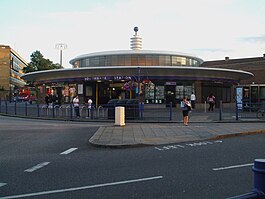Southgate tube station
| Southgate |
|
|---|---|
 |
|
|
Location of Southgate in Greater London
|
|
| Location | Southgate |
| Local authority | London Borough of Enfield |
| Managed by | London Underground |
| Number of platforms | 2 |
| Fare zone | 4 |
| London Underground annual entry and exit | |
| 2012 |
|
| 2013 |
|
| 2014 |
|
| 2015 |
|
| Key dates | |
| 1933 | Opened (Piccadilly Line) |
| Listed status | |
| Listing grade | II* (since 28 July 2009) |
| Entry number | 1188692 |
| Added to list | 19 February 1971 |
| Other information | |
| Lists of stations | |
| WGS84 | 51°37′57″N 0°07′41″W / 51.6325°N 0.12805°WCoordinates: 51°37′57″N 0°07′41″W / 51.6325°N 0.12805°W |
|
|
|
Southgate is a London Underground Piccadilly line station in Southgate. It is located between Arnos Grove and Oakwood stations and is in Travelcard Zone 4.
Southgate station opened on 13 March 1933 with Oakwood on the second phase of the northern extension of the Piccadilly line from Finsbury Park to Cockfosters. Prior to the station's opening, alternative names were suggested including "Chase Side" and "Southgate Central". On opening, local residents were given a free return ticket to Piccadilly Circus.
The station is built in the Art Deco/Streamline Moderne design style using brick, reinforced concrete and glass and is one of the best known of the many stations Charles Holden designed for London Underground. The station building is circular with a flat projecting concrete roof. Externally, the flat roof of the raised central section appears, impossibly, to be supported by nothing more than a horizontal band of windows that provide daylight to the ticket hall. The roof is actually supported, umbrella-like, from a central column within the ticket hall. The whole building is topped by an illuminated feature resembling a Tesla coil.
Like Arnos Grove, Oakwood and Cockfosters, Southgate is a listed building in this case at Grade II* (regraded from Grade II in 2009) and retains much of its original decoration. The two escalators have the original column lighting, while bronze panelling is in evidence throughout the station. However; the station is not without change: in the late 1990s, one of the three entrances was filled in to be used as a new ticket office, and due to the design of the automatic barriers, one of the two remaining entrances is exit only.
...
Wikipedia

